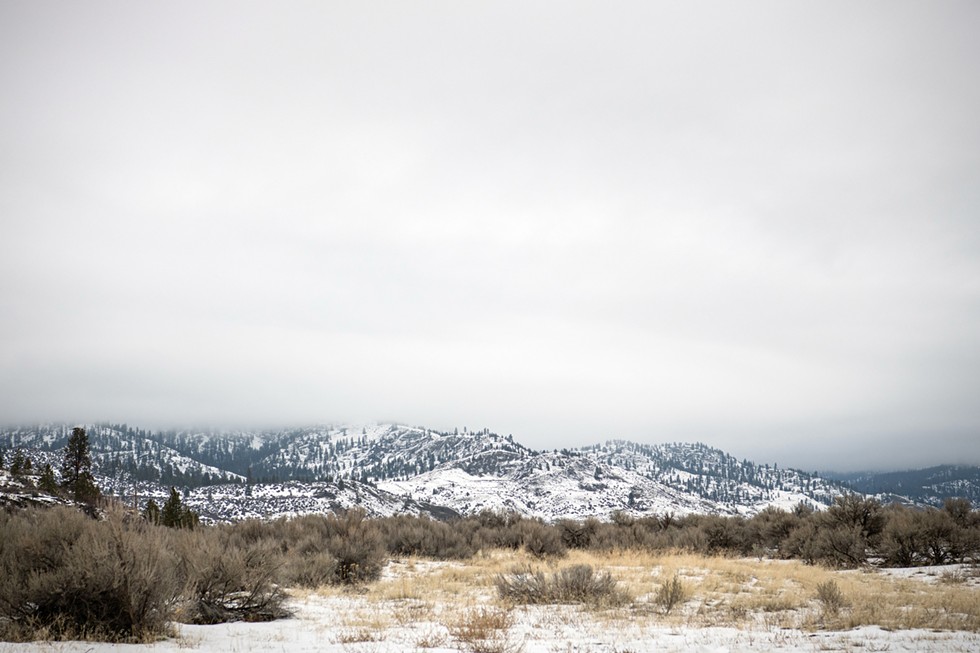As the big moment approaches, a hush falls over the dozen or so people gathered high on a snowy logging road in the Kettle Range in north central Washington.
They walk through the snow as quietly as possible as a covered animal crate is delicately moved from the back of a truck and placed in front of a snowbank.
Inside, a wild female lynx lets out a low growl as she hears the crunching footsteps of those gathered to document this moment.
She's the sixth lynx that the 12 Confederated Tribes of the Colville Reservation have captured in Canada in order to return the species to this lower stretch of their original high elevation range in the U.S. Over-trapping and western expansion contributed to the decline of the original population here, and now lynx are rarely seen on this landscape. But if all goes well, that's about to change.
Over five years, the tribes hope to relocate 10 lynx per season from a healthy population that lives in British Columbia, for a total of about 50 animals. If the wildcats stick around, the tribes and conservation groups working together could successfully reintroduce the species to the region.
As the group prepares for this release on the afternoon of Sunday, Jan. 16, tribal council member Jarred-Michael Erickson (who previously worked as a tribal biologist) dons medical gloves and slowly opens the door to the crate.
For a moment, the lynx lingers inside the carrier. But after Erickson gently taps on its back covering, the wildcat deftly hops up onto the snow, her oversized feet distributing her weight like furry snowshoes as she runs into the woods that will become her new home.
Lynx are a little bigger than bobcats, usually weighing 15 to 30 pounds as adults. They're known for their tufted ears, long legs and huge paws that enable them to chase prey in higher elevations where other predators can't pass over the snow as easily. Most records in Washington point to their historic presence in Okanogan, Chelan, Ferry, Stevens and Pend Oreille counties.
"It's getting those rare forest carnivores back on the landscape, righting a wrong that was done," Erickson says of the lynx restoration work. "There's a place for every animal in the ecosystem."
With 12 different tribes with 12 unique cultures represented within the Colville Reservation — which at 1.4 million acres represents just a small fraction of those tribes' homelands — Colville Tribes Natural Resources Director Cody Desautel says he doesn't want to speak specifically to the cultural importance of lynx for Native Americans in the area. But, he says there are cultural ties to every animal on the landscape.
"I think tribes believe that all things have their place in nature," Desautel says. "So we recognize that and do recognize that to have those proper functions, and to have those cultural ties that we had to those animals, they need to be present on the landscape."
As lynx-trapping efforts wrap up for this first season, the team of scientists working on the reintroduction are already eager to dive into many research opportunities the project presents. GPS collars will help the tribes' scientists track the animals' locations twice per day for up to about four years each, and they'll try to find each animal for further study once they perish.
Among the questions they want to answer: How far will the cats roam? How much will they interact? How quickly could they reproduce and establish their homes here?
The lynx are just the latest in a series of reintroduction efforts the Colville tribes have taken on over the past few decades in hopes that some of the many animals pushed out over the years can be restored. Land management, climate change, wildfires and food sources will all come into play as those species try to regain a foothold.
"We've been very active in our management to try to build in some landscape resilience," Desautel says. "It's probably a good testing ground to see, will these things persist on the landscape in a changing climate and a changing disturbance regime? And if they do, where will they go, and how do they move across the landscape?"
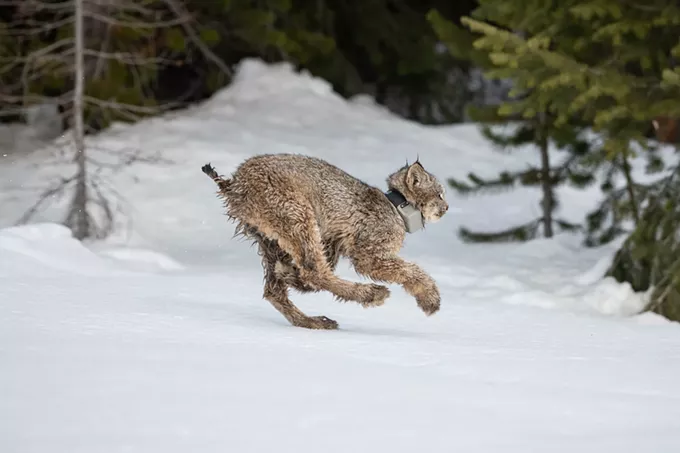
YEARS IN THE MAKING
While October and November 2021 marked the start of the first live lynx-trapping season for the tribes, the restoration project was many years in the making.Back in the early 1990s, the Bellingham-based environmental nonprofit Conservation Northwest started working on getting the Canada lynx federal protections under the Endangered Species Act, as well as state protection. With populations stretching across Alaska, Canada and northern parts of the U.S., Canada lynx are thriving and trapped for fur in Canada, while they're considered threatened in the U.S. at the federal level, and endangered in Washington state.
By 2007, Conservation Northwest had started a cross-border WildLinks conference with Canadian First Nations, Native American tribes, state and provincial government agencies, and more, meeting regularly to discuss land management and the survival of the species in western North America, explains Dave Werntz, science and conservation director for the nonprofit.
Out of that work came three priorities, Werntz says: protect lynx habitat in the Okanagan/Okanogan region, identify different populations that can help maintain genetic diversity, and restore lynx to the Kettle Range. But getting there would mean finding someone interested in taking on the physical work.
Animal restoration work was not new to the Colville tribes' biology department. While it's mostly been a small, passionate group, the staff there have taken on massive projects over the years.
In his work as the principal wildlife biologist for the tribes, Eric Krausz helped oversee many of those restoration projects over the last 20 years.
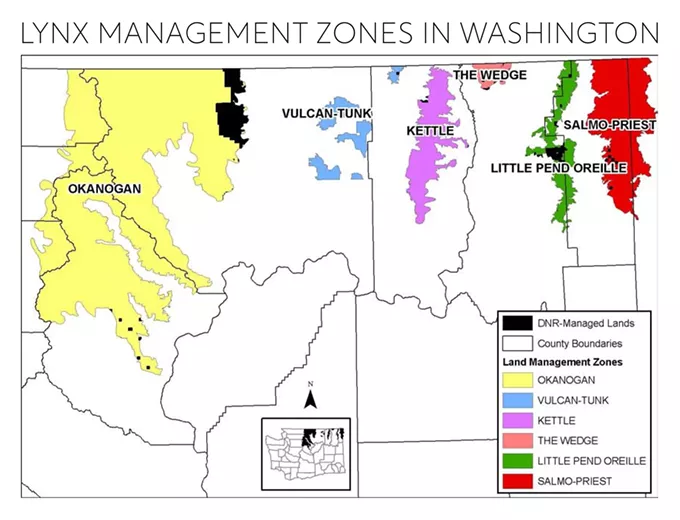
Early work included reintroducing elk back in the late 1970s and early 1980s. In the early 2000s, around the time that Krausz started working there, he says they started trapping sharp-tailed grouse in Idaho and relocating some of the birds to the reservation. In the mid-2000s, they relocated bighorn sheep from areas of the state near Yakima. The sheep specialize in rocky terrain with wide, horizontal views and are suited to parts of the reservation, Krausz says.
"One of the things that's always been a priority in our population program has been when we have an opportunity to try to right a wrong or bring back something that used to be here, we put that front and center," Krausz says.
More recently, around 2016, pronghorn antelope were brought back to some of the traditional areas they lived in.
Krausz recalls meeting with hunting groups and land managers in Nevada as the tribes sought permission to relocate some of the antelope that are thriving there. One of the hunters asked why they should allow some of their herd to go to this tribe in north central Washington. Krausz says one of the head wildlife managers framed it elegantly:
"He basically said, 'If you're not familiar with the history of our wildlife in the West, from elk to mountain goats, to bighorn sheep, most of the populations of these species in the Western United States have been reintroduced from other states or provinces in Canada that had an abundance,'" Krausz says. "He was like, 'I feel like it's our duty to give back, like we've been given to.' That's the whole idea of how we keep these populations thriving; we try to right our wrongs and help each other out as a management community."
After building a successful track record with the various reintroduction projects, Krausz says he was approached by several people at one of those WildLinks meetings a few years ago.
"They asked, 'Would you guys ever be interested in wanting to take on the lynx reintroduction? You're right there in the heart of the Kettles,'" Krausz recalls.
He took it back to his boss, and they dove right in.
Most importantly, Krausz says their team was growing, and he was able to bring Senior Wildlife Biologist Rose Piccinini back on board to spearhead the project.
Hands-on biology work like lynx reintroduction can often appear glamorous, with days spent adventuring out into the woods on snowmobiles and carefully handling animals the rest of us can only dream of getting close to. But Krausz emphasizes that the work is also a grind that often requires long stretches spent away from your family and lots of behind-the-scenes labor.
"There's a lot of hard work that's involved," Krausz says. "I'm super proud of our work we continue to do in our team, especially with the challenges we are faced with."

WHAT IT TAKES TO MOVE A WILDCAT
By the time Piccinini is able to connect with the Inlander over the phone on Feb. 4, she's just gotten home from three straight weeks working the trapline near Kelowna, British Columbia. In fact, she's only home to spend two days with her family for a celebration, do some laundry and then head right back up north."People have been amazing at shifting their working lives to accommodate this project," Piccinini says. "It's had a lot of growing pains, and if it hadn't been my son's 8th birthday party, I would still be up there."
While the team had hoped to capture all 10 lynx for this year before Feb. 4, by that point, they'd only caught and released seven. This time of year, the Colville Tribes Fish and Wildlife staff usually gears up for winter helicopter flights to track big game, she says, and that work needs to happen, too. But the team made the call to go back up to Canada last week for one more stretch, in hopes of snagging the last three lynx before returning to their other important biology work at home.
Luckily, the decision to head back up paid off. By Wednesday, Feb. 9, they were able to transport and release a 30-pound male lynx, and on Thursday they released another female, making the total for this year five females and four males.
"When I think about what we've already accomplished this year, it's sort of mindblowing," Piccinini says. "We have lynx on the ground in the Kettles, and to me that's already been a success."
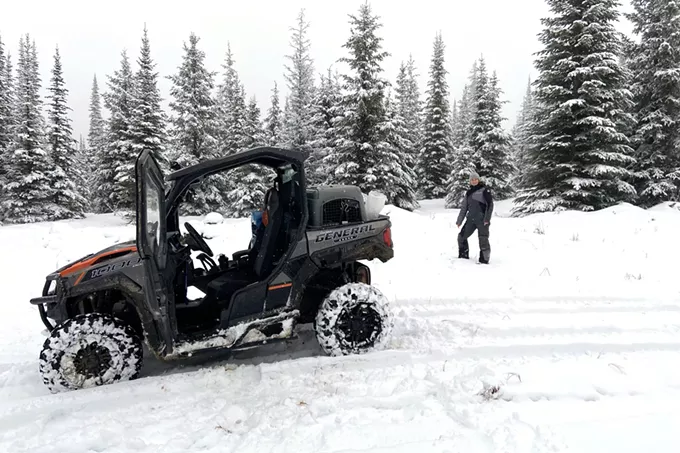
Just a year ago, she was helping coordinate seemingly endless calls with tribal, federal and private agencies in two different countries to get permits, permissions and paperwork. It takes a lot of coordination to export wild animals from one country where they are legal to hunt and import them into another where they are federally protected.
Piccinini coordinated with the U.S. Department of Fish and Wildlife Services (USFWS), the U.S. Department of Agriculture, the First Nations that are part of the Okanagan Nation Alliance, and the British Columbia provincial government agency that oversees hunting and trapping. She notified the Washington Department of Fish and Wildlife that lynx would be back, in case they stray onto state lands. Plus, she secured grants from USFWS and the Bureau of Indian Affairs, and helped coordinate funding with CREOi (Conservation, Research and Education Opportunities International), the National Fish and Wildlife Foundation, and Conservation Northwest, which has helped pay for the trappers.
Part of the success of the project, it seems, is that everyone has just been plain excited about restoring the cats to the Kettles, she says.
"That's been one of the overarching themes for this thing: From the beginning, everybody we told about it was excited about it," Piccinini says. "As our team came across the border with a cat, all the customs agents on both sides would be so excited, like, 'Yes! You got one!'"
The work is also helping establish relationships between some unlikely allies — those who've usually caught lynx to sell their pelts and those hoping to keep them alive.
"We have lynx on the ground in the Kettles, and to me that's already been a success."
tweet this
LEARNING TO TRAP
Once the right permissions were in place, Piccinini's team coordinated with a local trapping association in British Columbia to find trapline owners who were willing to forgo fur trapping in order to capture up to five live lynx on their lines this season under the agreement for the project."Traplines" are geographic areas controlled by the trappers who own them. When it comes to fur trapping, they are largely self-regulated. But those who agreed to livetrap lynx for the project would not be allowed to kill trap at the same time.
Thankfully, with the exciting prospect of helping the tribes restore the lynx population to the lower Kettles, two traplines agreed to help.
Piccinini says the coordination has been incredible. For starters, no one had any experience livetrapping lynx, so they all had to figure it out together.
"We kind of learned on the fly," explains trapper Trent Weninger, a retired cemetery worker who grew up in Kelowna and invested in a roughly 300-square-kilometer trapline a few years ago with a friend as a hobby. "We've never done [livetrapping], never seen it, never even read about it."
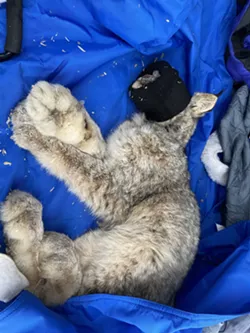
Piccinini and the Okanagan Nation Alliance did some research on live traps and developed some box traps to use for the lynx project. But as with all new things, they are still making tweaks and realizing which improvements need to be made.
At some points, cold weather and ice would freeze the metal lining and prevent the door — rigged with fishing wire and a mouse trap — from closing when a cat went in to take the bait, Weninger says.
At other times, birds commonly referred to as whisky jacks would get into the traps to nip at the bait. Having the birds themselves hanging out around the trap is actually good to attract lynx, Weninger explains, even though the cats' diet consists almost entirely of snowshoe hare. But sometimes the birds created missed opportunities when they triggered the traps.
"Adjusting those traps is an ongoing process. We have trail cams on every trap," Weninger says. "You could see the whisky jack shut the door and here comes a cat walking by. We got a couple videos of a cat sitting on the cage trying to figure out how to get in."
Next season they'll likely try to make the traps appear more natural to increase success.
The opportunity to work on live capture has been particularly rewarding for Weninger, who says he has been an avid outdoorsman since childhood. He's always treated the animals he hunts with respect, but he says this allowed for a new type of fulfillment from the time spent outdoors.
"I'm feeling better about trapping them live and they serve a purpose, rather than a little bit of money in your pocket," Weninger says. "It feels better."
Werntz says Conservation Northwest is compensating the trappers well over what they would normally receive, and Weninger confirms that there's not really much money to be made in fur trapping anyways.
"For like a lynx you trap and kill, you might get about $75," Weninger says. "It costs us like $60 to go out on the snowmobile for the day, and that's not counting the truck to get there, so there's no money in trapping."
It's mostly been a hobby due to that, he says. But the project has opened up an even closer connection to the animals.
Piccinini says there were some special moments with the trappers on the two different lines as they got to witness the biologists do their work.
Once a lynx is captured and sedated, the scientists quickly work to take hair and DNA samples, put on an ear tag, adjust a GPS collar to the animal, and measure them.
While they do so, someone is constantly monitoring the animal's temperature, heart rate and breathing.
"The human dynamics, the background of biologists working with trappers, it was a lot of fun," Piccinini says. "We gave the stethoscope to the trappers so they could hear the heartbeat of the lynx. It's making those connections that are pretty cool, and changing the way they might see an animal on the landscape."
Usually when scientists and outdoors people meet, they have two different theories, Weninger agrees.
"But it's almost like we've been friends for years when you're out there. It's been great working with them," he says. "I think it's a good opportunity for us up here to be able to help introduce the lynx so they can be shared with the bands down there on their lands and looked after."
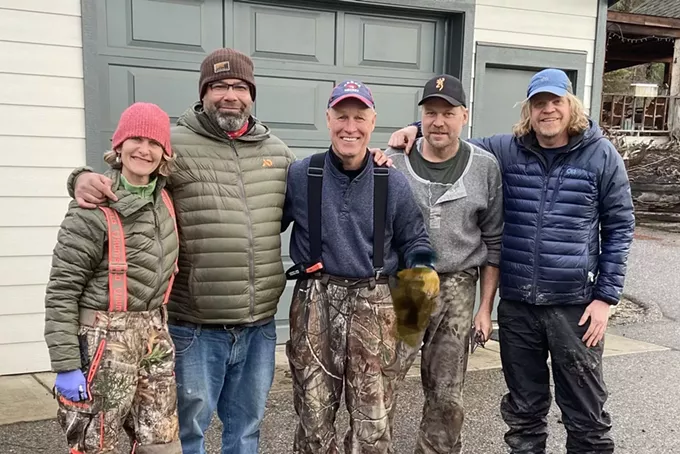
NEW GENERATION, OLD CONNECTIONS
Back in the fall, as the team first started working to trap lynx on the two separate traplines in British Columbia, emotions were high on their first day of success.As Piccinini and Donovan Antoine, a Colville tribal wildlife technician, drove down the mountain in a side-by-side utility vehicle, they had the first female lynx of the project in tow.
That would have been exciting enough, but radio chatter from the team on the other trapline confirmed they'd also caught a male.
With successful captures of a potential mating pair on the same day, it felt like things were falling right into place, Piccinini says.
"It was an extremely exciting day," she says. "We finally realized everything we had put into this was working — we had actually caught cats."
In academia, scientists are often taught not to name the animals they're researching. But with this particular project, there is much more of a personal connection, she says.
So, an enthusiastic Piccinini turned to Antoine and asked what they should name the animals. Even if science said not to, he agreed that seemed fitting, telling Piccinini that "these animals mean more to us than numbers."
The two talked about how to honor the cats' return to the landscape. Rather than just think about the project as an experiment to see if they can thrive moving forward, it's also important to remember that this is a way of returning the animals to their ancestral homelands, Piccinini says.
"[Antoine] came up with the names 'Grandfather' and 'Grandmother,' because in tribal tradition, when you talk about grandfather, it's almost like a conceptual idea of a creator all the way down for all the generations," Piccinini says. "That's so fitting, honoring all of the lynx that came before. But you're also sort of preparing for this new generation back on the reservation. ... I thought that was fitting, and cosmic that they both got caught on the same day." ♦

